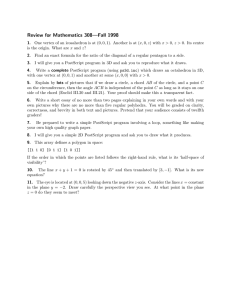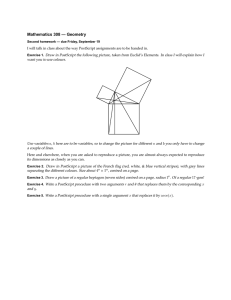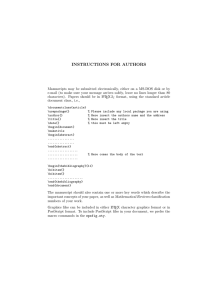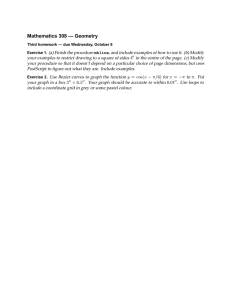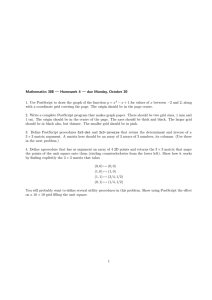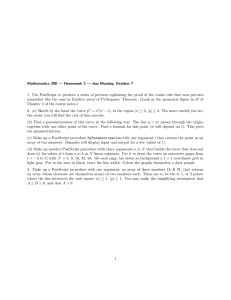Graphics inclusions in manuscripts
advertisement
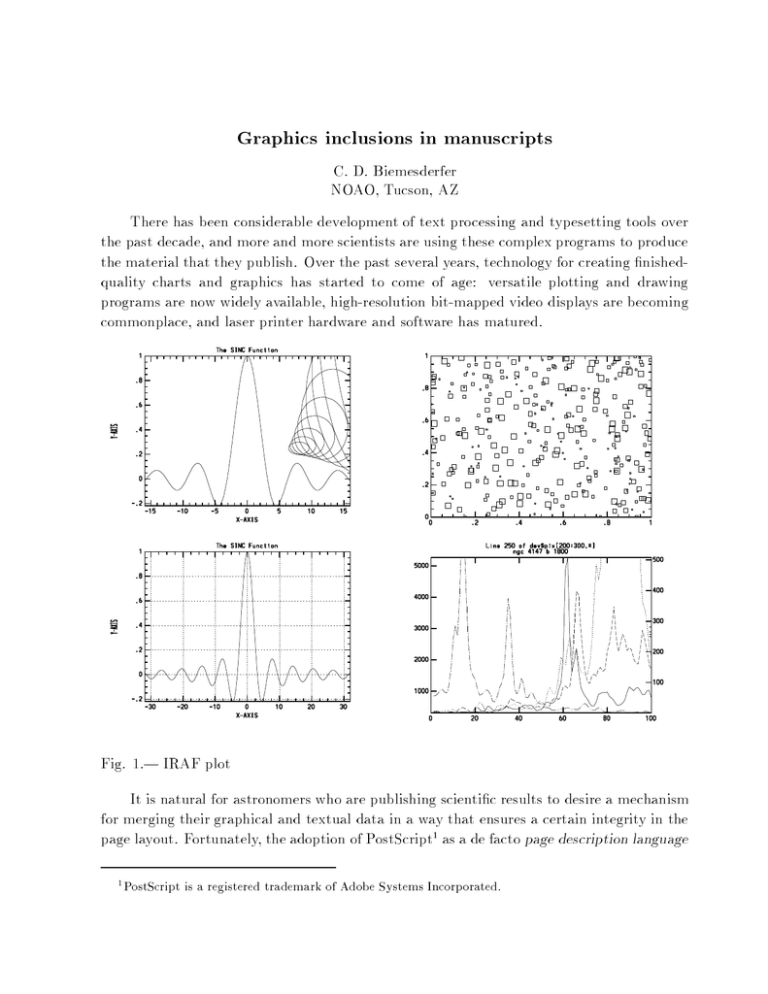
Graphics inclusions in manuscripts
C. D. Biemesderfer
NOAO, Tucson, AZ
There has been considerable development of text processing and typesetting tools over
the past decade, and more and more scientists are using these complex programs to produce
the material that they publish. Over the past several years, technology for creating nishedquality charts and graphics has started to come of age: versatile plotting and drawing
programs are now widely available, high-resolution bit-mapped video displays are becoming
commonplace, and laser printer hardware and software has matured.
Fig. 1.| IRAF plot
It is natural for astronomers who are publishing scientic results to desire a mechanism
for merging their graphical and textual data in a way that ensures a certain integrity in the
page layout. Fortunately, the adoption of PostScript1 as a de facto page description language
1
PostScript is a registered trademark of Adobe Systems Incorporated.
{2{
standard by a substantial fraction of the relevant sectors of the industry makes it simpler
for programmers to set up the machinery.
1. Why PostScript is good
PostScript has a number of merits that make it a good choice as the language to use for
graphics exchange. Most important is that it is a device-independent means of describing
printing on a page, and has been widely implemented across a variety of printers and display
devices. It is fairly well-documented and tested, so dierent implementations work reliably
and behave predictably.
Furthermore, PostScript is composed of text using the ASCII character set. This makes
is very easy to transport les on networks, and they are susceptible to manipulation by
standard text processing tools, e.g., editors, pagers, etc.
1.1. Encapsulated PostScript
It is desirable for graphics inclusions to conform to certain codes of behavior, so that
the graphics can be manipulated readily and reliably. PostScript can be generated at any
of several levels of so-called structuring conventions, which are a more or less inevitable
consequence of PostScript's heritage as a programming language.
When a PostScript program is to be interpreted as a simple page description, it is
convenient if it obeys some rules of form. For the purposes of graphics inclusion, the most
important property is that the PostScript be encapsulated. What this means essentially is
that the including application can determine the size and location on the page of the graphic
without having to interpret any PostScript code.
The boundaries of such a \capsule" graphic are dened by a BoundingBox comment that
species the and coordinates of two opposing corners of the graphic. There are other
\do's and don'ts" in the quest to produce encapsulated PostScript however, it is generally
sucient for the including application to specify that imported PostScript graphics conform
to the encapsulation standard.
x
y
2. Overview of the DVIPS commands
{3{
This is intended as a cursory look at the commands that can be used to work with
graphics inclusions. It is by no means necessary for authors to know any of this markup
language writers can easily shield the end-user from all of the details of the PostScript
interface.
A graphic that is delivered to an application in a capsule dened by a bounding box
can be subjected to a limited number of operations: translation, truncation, scaling, and
rotation. Translation, truncation (called clipping in PostScript context), and scaling can be
performed on each coordinate independently, hence we can identify seven primitive functions:
hoffset
hsize
hscale
angle
horizontal oset
horizontal clip size
horizontal scale factor
rotation angle
voffset
vsize
vscale
vertical oset
vertical clip size
vertical scale factor
For most graphics inclusions, scaling is the most important function. It is rare to clip or
rotate imported graphics, and moving the coordinate system origin from the current point
is often troublesome in a text formatter. Furthermore, there is usually no reason to alter
the aspect ratio of the graphic, so including encapsulated PostScript is often as simple as
specifying a scale factor or a dimension and reading the le.
Fig. 2.| Dual IRAF plots
3. Implications for the AASTEX package
We are concerned with the import of two-dimensional graphics and grey-scale images
into scientic manuscripts and other technical documentation. At this point in time, it
should be adequate to require that all graphics for import be in the form of encapsulated
{4{
PostScript, and to declare that gures will be imported in their entirety and with the same
aspect ratio as in the original. It is then trivial to build some simple macros based on the
epsf substyle that is supplied with the DVIPS program by its author, Tom Rokicki.
The epsf macros we need to worry about are \epsfscale, \epsfxsize and \epsfbox,
which perform the two functions we determined in the preceding section to be critical. For
purposes of having prototype macros, I wrote two simple macros:
\plotone{FILE} reads the PostScript in FILE and adjusts the scale such that the coordinate width of the graphic matches \epsfscale times the \textwidth of the
manuscript. Figure 1 on page 1 is an example.
\plottwo{FILE1}{FILE2} reads the PostScript from two les and scales each to t across
half the \textwidth (actually, slightly less than half so the graphics don't collide).
Figure 2 on page 3 shows a pair of dueling inclusions.
The arguments to the \plotone and \plottwo commands should not include additional
scaling and rotation information. These commands are part of the AASTEX markup conventions, but it is entirely reasonable for authors to use the markup syntax of DVIPS for
handling encapsulated PostScript graphics. If direct access to the graphic is desired, it is
necessary to use the interface syntax dened by Rokicki.
x
Fig. 3.| Inverted IRAF plot
One has to be careful, though, when using this approach, since the automatic link
between the formatter (LATEX) and the PostScript is abandoned. One can get great eects,
or totally funky ones
:::
{5{
4. When the easy way fails
If the \plotone or \plottwo command puts your gure in as unexpected location, the
BoundingBox in the gure is probably wrong, meaning that it doesn't tell DVIPS where the
gure really sits on the page. The best thing to do is to x the BoundingBox. It's pretty
easy. If you can print your gure, hold the page in portrait orientation as it came from the
printer. Now draw the smallest rectangle, with edges parallel to the edges of the paper, that
circumscribes all of the printed marks on the page. This is the BoundingBox. Measure the
and coordinates of the lower left and upper right corners of the rectangle, in that order, in
units of 721 of an inch with the origin at the lower left corner of the paper. For example, if the
box you drew was one inch from three edges of the paper and two inches from the bottom,
the four numbers would be \72 144 540 720." Now edit the le containing the PostScript
gure. Towards the top of the le, you should see a line containing %%BoundingBox: followed
by a space (important!) and four numbers. Replace the numbers that appear in the le with
the numbers you measured, save the result, and reformat your document (run LATEX again).
Your editor will appreciate your taking these steps.
Some applications may create encapsulated PostScript les that create other problems. PostScript les created by FrameMaker are known to cause problems. C shell
scripts called fixfm4 and fixfm5 can be downloaded from ftp.irisa.fr, from the directory pub/FrameMaker/Filters. These scripts will repair the PostScript les generated
by FrameMaker versions 4 and 5, respectively.
x
y
{6{
Fig. 4.| Mangled IRAF plot
